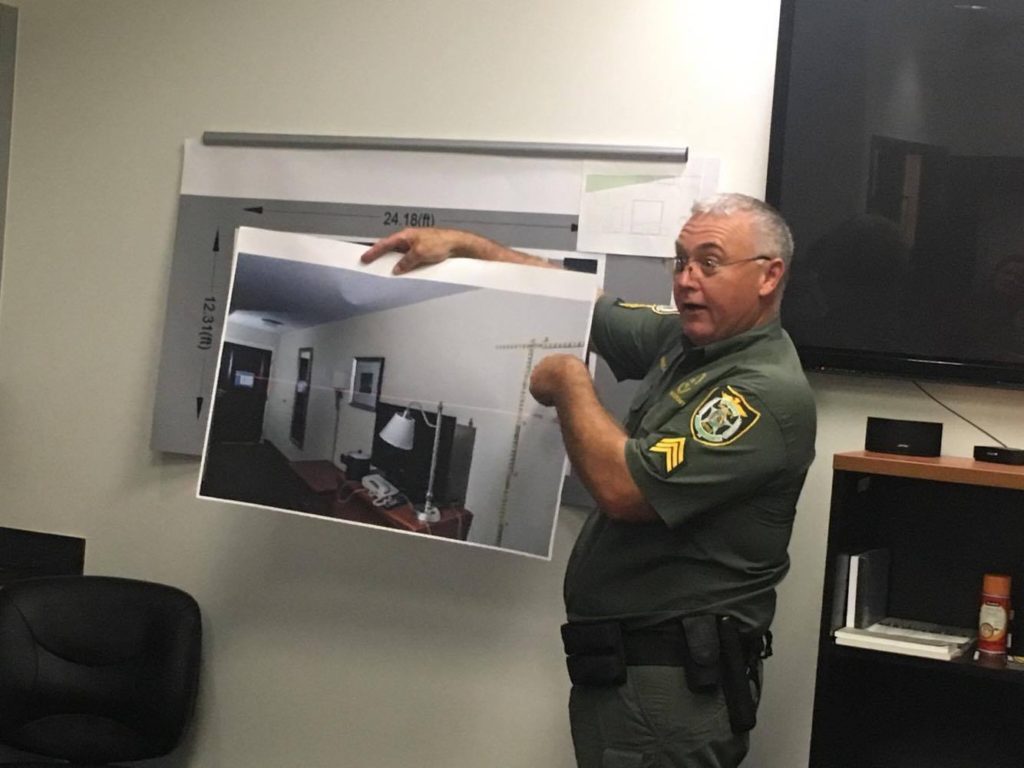INDIAN RIVER COUNTY — DNA and fingerprint processing, taking photos of criminals and storing vehicles used in crimes are just a few things that take place at the Indian River County Sheriff’s Office Crime Lab.
The lab is located in the forensic services building on 41st Street, around the corner from the Sheriff’s Office at 4055 41st Ave., Vero Beach.
The Crime Scene Unit brings evidence collected at crime scenes back to the lab for further processing, said Detective Sgt. Kyle King, who oversees the unit. The unit has four investigators, two digital forensic specialists, two evidence custodians, two latent examiners and one supervisor.
The lab has different areas, including an imaging and reconstruction studio, a processing lab, conference room, vehicle processing bay and an evidence storage facility. The DNA and fingerprint processing is done in the processing lab.
It usually takes a month to get results from DNA testing, but updated technology at the crime lab allows detectives to get DNA test results in about an hour an 30 minutes, King said. Detectives use a $200,000 machine called the Rapid Hit 200, which can test seven samples at a time.
“While at the crime scene, we send a detective back to the lab to process the DNA,” King said. “It gives us real time data that tells us answers to questions we have while we’re still at the scene.”
With the rapid DNA testing, detectives can quickly determine who the DNA belongs to, if it’s from one person or multiple people and more. Any DNA samples that can’t be tested by the Rapid Hit 200 are sent to the Indian River Crime Lab, which is a regional crime lab located on the public safety complex at Indian River State College in St. Lucie County.
For drugs, detectives conduct presumptive testing.
“Our testing is enough to make an arrest,” King said. “(The substance) can test positive for cocaine, but it still needs to be sent to the regional crime lab so they can determine if it’s an actual drug.”
Detectives use the Superglue Fingerprint Chamber to find fingerprint marks left behind on items, King said. Detectives pour the superglue into a container within the chamber and allow the fumes to surround the object, which exposes the oils of the fingerprint marks.
King said detectives also use a chemical spray to find fingerprints hidden on paper documents. A machine called the Crimescope Light Machine helps detectives find and enhance fingerprints, bodily fluids, hairs, fibers and more.
Detectives take pictures of victims, criminals, and sometimes recreate a crime scene with pieces of evidence inside the imaging and reconstruction studio. The studio has well equipped cameras, light modifiers, high ceilings and black walls so that detectives can have complete control of the lighting.
Sometimes, detectives have to call victims back to take more pictures because their injuries might not be noticeable to the camera right away.
“A recent injury you get today might be more noticeable two or three days from now because of bruising,” King said. Criminals usually are photographed once, and then taken to the jail. Not all pictures of criminals are taken at the studio.
A garage at the lab stores the Mobile Command Center, which is a large van detectives use when they’re at a crime scene for a long time. The van has 3-D scanners that allow detectives to create a digital representation of the crime scene.
It also has DNA evidence collection gear and allows detectives to have full communication with the Sheriff’s Office main building so they can access the network.
“It’s a really valuable piece of gear that makes things easier at the scene,” King said.
Also at the lab is a vehicle processing bay. Vehicles used in crimes that belong to suspects or victims will go to the bay for inspection.
“Sometimes it’s a car that has been shot up,” King said. After inspection, the vehicles go to the evidence storage facility.

